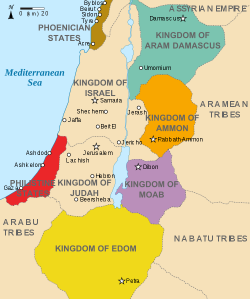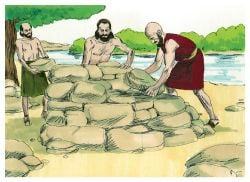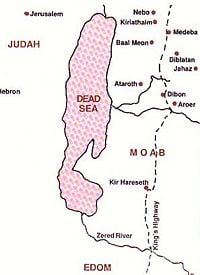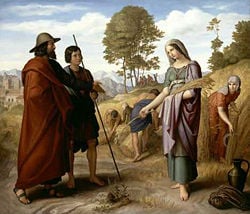Moab
Moab (Hebrew: ××Öš×Ö¸× â MoĘžav; Greek: ÎĎΏβ) is the historical name for a mountainous strip of land in modern-day Jordan running along the eastern shore of the Dead Sea. In ancient times, it was home to the kingdom of the Moabites, a people often in conflict with their Israelite neighbors to the west. The Moabites were a historical people, whose existence is attested to by numerous archaeological finds, most notably the Mesha Stele, which describes the Moabite victory over an unnamed son of King Omri of Israel (2 Kings 3). Their capital was Dibon, located next to the modern Jordanian town of Dhiban.
In the Bible, the Moabites are said to be descended from Abraham's nephew, Lot, and were thus not included among the peoples to be driven out by the Israelites when they entered Canaan. The Israelite tribes of Reuben and Gad settled among them, sometimes living peacefully and occasionally causing concern of disloyalty among other tribes. King David was of Moabite lineage through his great-grandmother, Ruth.
A Moabite king reportedly conquered parts of Israel during the period of the judges. King David conquered Moab and forced it to become a vassal state. It remained a vassal to the northern Kingdom of Israel after Israel and Judah separated. Later it rebelled against Israel's dominance. The biblical account of the result of this rebellion seems to be at odds with what is claimed on the Moabite document known as the Mesha Stele, in which the king of Moab boasts of victory over Israel. The Moabites disappear from the historical record sometime after the Jews returned from their Babylonian exile. In some sources they are identified as Arabs.
The country
People
In the biblical narrative, the Moabites were relatives of the Israelites, sharing a common ancestor, Terah, the father of the brothers Abraham and Haran. Haran was the father of Lot, who was the father of Moab and Ammon. Intermarriage between Israelites and Moabites was not forbidden as it was concerning Canaanite tribes, but children of mixed marriages with Moabites or Ammonites were considered mamzers, meaning that they could not enter fully into the "congregation" of Israel until the tenth generation. This rule, however, must belong to a later time, for Israel's most pious king, David was of Moabite descent with only three generations intervening.[1]
The Moabites had apparently close ties to the clans of Jacobâs sons Reuben and Gad, which settled in the Transjordan region of Moab, together with part of the tribe of Manasseh. Some scholars hold that elements of Reuben and Gad may have remained in Moab while the other Israelites migrated to Egypt, or even that they were Moabite clans who were later adopted into the Israelite federation. This would explain why these tribes asked to remain east of the Jordan rather than entering Canaan with the other Israelites.
It is noteworthy that while Deuteronomy 2:9 specifies that God does not authorize the Israelites to take any Moabite territory, Numbers 32:34-39 states:
The Gadites built up Dibon, Ataroth, Aroer, Atroth Shophan, Jazer, Jogbehah, Beth Nimrah and Beth Haran as fortified cities, and built pens for their flocks. And the Reubenites rebuilt Heshbon, Elealeh and Kiriathaim, as well as Nebo and Baal Meon (these names were changed) and Sibmah. They gave names to the cities they rebuilt. And the children of Machir the son of Manasseh went to Gilead and took it, and destroyed the Amorites who were in it...
These places for the most part lie north of Moabite territory as the Bible defines it, but the Mesha Stele makes it clear that the Moabites themselves by no means accepted this fact.
Disputes also arose between the Israelites of Canaan and the tribes that settled to the east among their Moabite cousins. One instance involved the construction of a large altar near the Jordan. Such an altar could be offensive for several reasons.[2] The Israelites prepared for war, but the priest Phinehas received assurances that those who had settled among the Moabites remained faithful to Yahweh and that the shrine was âto be a witness between us and you and between the generations after us, that we will perform the service of the Lord before Him with our burnt offerings and sacrifices and peace offeringsâ (Josh. 22:26-27).
Religion
References to the religion of Moab are scarce. Most of the Moabites were polytheists, like the other early Semites, including many of the Israelites, whom they induced to join in their sacrifices (Num. 25:2; Judg. 10:6). Their chief god was Chemosh, so that the Israelites sometimes referred to them rhetorically as the "people of Chemosh" (Num. 21:29; Jer. 48:46). At times, especially in dire peril, human sacrifices were offered to him, as by Mesha, who gave up his son and heir to him (2 Kings 3:27). However, the Israelite god Yahweh seems also to have been honored by them, as evidenced by the episode of Balak and Balaam. Yahweh himself is portrayed as giving their land to the Moabites, and specifically not to the Israelites (Deut. 2:9).
Just as Yahweh worship was practiced at times in Moab, so the worship of Chemosh was practiced in Israel and Judah. King Solomon built on a hill near Jerusalem, a "high place" for Chemosh (1 Kings 11:7) which was not finally destroyed until the reign of Josiah (2 Kings 23:13). The Mesha Stele, also called the Moabite Stone, mentions (line 17) a female counterpart of Chemosh, Ashtar-Chemosh, and a god Nebo (line 14), after whom Mount Nebo was called. This deity may be the well-known Babylonian god Nabu. The cult of Peor, also called Baal-peor (Num. 25:5; Ps. 106:28; Josh. 22:17), seems to have been marked by sexual rites, though this may be an exaggeration of simple sexual unions between Israelite men and Moabite women.
Economy
The country of Moab was the source of numerous natural resources, including limestone, salt and balsam from the Dead Sea region. The Moabites occupied a vital place along the King's Highway, the ancient trade route connecting Egypt with Mesopotamia, Syria, and Anatolia. Like the Edomites and Ammonites, trade along this route gave them considerable revenue.
Geography
Moab occupied a plateau about three thousand feet above the level of the Mediterranean Sea, or 4,300 feet above the Dead Sea, and rising gradually from north to south. It was bounded on the west by the Dead Sea and the southern section of the Jordan River; on the east by Ammon and the Arabian desert, from which it was separated by low, rolling hills; and on the south by Edom. The northern boundary varied, but in general it may be said to have been represented by a line drawn some miles above the northern extremity of the Dead Sea. In Ezekiel 25:9, the boundaries are given as being marked by Beth-jeshimoth (north), Baal-meon (east), and Kiriathaim (south).
These boundaries were not fixed, however, as is plain from the lists of cities given in Isaiah 26-26 and Jeremiah 48, where Heshbon, Elealeh, and Jazer are mentioned to the north of Beth-jeshimoth; Madaba, Beth-gamul, and Mephaath to the east of Baalmeon; and Dibon, Aroer, Bezer, Jahaz, and Kirhareseth to the south of Kiriathaim. The principal rivers of Moab mentioned in the Bible are the Arnon, the Dimon or Dibon, and the Nimrim.
The limestone hills which form the territory's almost treeless plateau are generally steep but fertile. In the spring they are covered with grass; and the tableland itself produces grain. In the north are a number of long, deep ravines, and Mount Nebo, famous as the scene of the death of Moses (Deut. 34 1-8). The rainfall is fairly plentiful; and the climateâdespite the hot summerâis cooler than the area west of the Jordan River, with frequent snowfall in winter and in spring.
The plateau is dotted with hundreds of rude dolmens, menhirs, and stone-circles, and contains many ruined villages, mostly of the Roman and Byzantine periods. The land is now occupied chiefly by Bedouin, though it contains such towns as al-Karak.
The territory occupied by early Moab, before the invasion of the Amorites, divided itself naturally into three distinct and independent portions: The enclosed corner or canton south of the Arnon, referred to as "field of Moab," (Ruth 1:1, 2, 6) the more open rolling country north of the Arnon, opposite Jericho, and up to the hills of Gilead, (called the "land of Moab" (Deut. 1:5; 32:49), and the district below sea level in the tropical depths of the Jordan valley (Num. 22:1).
History
Origins
The Moabites were likely pastoral nomads settling in the trans-Jordanian highlands. They may have been among the raiders referred to as Habiru referred to in the Amarna letters. Whether they were among the nations referred to in the Ancient Egyptian language as Shutu or Shasu is a matter of some debate among scholars. The existence of Moab prior to the rise of the Israelite polity can be seen from the colossal statues erected at Luxor by Pharaoh Ramesses II. On the base of the second statue in front of the northern pylon of Rameses' temple, Mu'ab is listed among a series of nations conquered by the pharaoh. The capital of Moab during this period was Kir-Hareshet (modern day Kerak).
Most of our knowledge about the Moabites, however, comes from the Bible, which was written by Moab's enemies in Israel and Judah. We have only one document from the Moabites themselves, the Mesha Stele; and it differs significantly from the biblical account.
Biblical Narrative

The biblical narrative describes the Moabites' origins in terms of both kinship and disdain. They are blood relatives of the Israelites, but their forefather was born as a result of incest. According to the story, Moab was the son of Abraham's nephew Lot, through his own eldest daughter, with whom he had a child after the destruction of Sodom. The Bible explains the etymology of Moab as meaning "of his father." Nevertheless, there was considerable interchange between the two peoples, and the Book of Ruth traces King David's lineage to a Moabite woman, Ruth.
According to Genesis 19:30-38, Moab's half-brother Ben Ammi, the product of a union between Lot and his younger daughter, was the ancestor of the Ammonites. The close ethnological affinity of Moab and Ammon[3] is confirmed by their subsequent history, while their kinship with the Israelites is equally certain, and is borne out by the linguistic evidence of the Moabite Stone. They are also mentioned in close connection with the Amalekites (Judg. 3:13), the Edomite inhabitants of Mount Seir (2 Chron. 20:22; Ezek. 25:8), the Canaanites (Ex. 15:15), the Sethites (Num. 24:17), and the Philistines (Psalms 40:10; Isa. 11:14).
The Moabites first inhabited the rich highlands at the eastern side of the chasm of the Dead Sea, extending as far north as the mountain of Gilead, from which country they expelled the Emim, the original inhabitants (Deut. 2:11), but they themselves were afterward driven southward by warlike tribes of Amorites, who had crossed the Jordan. These Amorites, described in the Bible as being ruled by King Sihon, confined the Moabites to the country south of the river Arnon, which formed their northern boundary (Num. 21:13; Judg. 11:18).
First contact
According to the biblical account, the Israelites, in entering the "promised land," did not pass directly through the Moabites (Judg. 11:18), but conquered Sihon's kingdom and his capital at Heshbon. Nevertheless, the Moabite prince Balak felt threatened by the Israelites' presence and hired the prophet Balaam to curse them. Here the Moabites are portrayed as being in league with the Midianites. That Balaam considered the Israelite deity Yahweh as "my God" (Num. 23:18) indicates that Yahweh worship was known and practiced in the region.[4] Much to Balak's dismay, Balaam only blessed Israel and predicted Moab's defeat:
- A star will come out of Jacob;
- a scepter will rise out of Israel.
- He will crush the foreheads of Moab,
- the skulls of all the sons of Sheth
While Israel camped at Shittim, Moabite and Midianite women engaged in sexual relations with Israelite men, both within marriage and outside of it (Num. 25). As a result, some of the Israelites joined these women in honoring the Baal of Peor, and Yahweh reportedly sent a plague which killed 24,000 Israelites. It was put to a stop only after the priest Phinehas, son of Aaron, killed an Israelite man together with his Midianite wife with a single spear thrust.
Before entering Canaan, the tribes of Reuben and Gad requested to settle in areas near or overlapping Moab. The Mesha Stele specifically refers to a later battle against Gad, and mentions that "the men of Gad lived in the land of Atarot from ancient times."
Mixed feelings
After the conquest of Canaan, the relations of Moab with Israel were of a mixed character, sometimes warlike and sometimes peaceable. Deuteronomy 2:9, describing a revelation to the Israelites from Moses commands: "Do not harass the Moabites or provoke them to war, for I will not give you any part of their land. I have given Ar to the descendants of Lot as a possession."
Nevertheless, serious warfare between Israelites and Moabites did erupt. The Bible reports that during the period of judges "the Israelites were subject to Eglon king of Moab for eighteen years." This probably refers only to a limited region including the "City of Palms" (a name associated with Jericho). Elgon brought about his victory over the Israelites in union with the Ammonites and the Amalekites (Judg. 3:12-30). The Benjaminite judge Ehud ended the crisis when he assassinated the Eglon leader and led an Israelite army against the Moabites at a ford of the Jordan River, killing many of them.
During the same period of the judges, however, the story of Ruth testifies to the existence of a friendly relations between Moab and Bethlehem, one of the towns of the tribe of Judah. Here, Elimelech and his wife Naomi are allowed to settle in Moab during a famine in Judah. Elimelech's sons marry Moabite women, with no hint of disapproval from the author. By his descent from Ruth, King David may be said to be of Moabite lineage. Close relations between Moabites and Israelites is also indicated by the report that Israelites worshiped not only Yahweh but also the "gods of Moab" during this period (Judg. 10:6).
David himself committed his parents to the protection of the king of Moab (who may have been his kinsman), when hard pressed by King Saul.
David went to Mizpah in Moab and said to the king of Moab, "Would you let my father and mother come and stay with you until I learn what God will do for me?" So he left them with the king of Moab, and they stayed with him as long as David was in the stronghold. (1 Samuel 22:3-4)
Later, however, David made war against Moab and forced the Moabites to be his tributary (2 Samuel 8:2; 1 Chronicles 18:2). In this campaign he reportedly killed two out of every three Moabite men left alive after their surrender, possibly a fulfillment of Balaam's earlier prophecy. David also plundered sacred items of the Moabites and dedicated them to Yahweh.[5] Moab was apparently under the rule of an Israelite governor during the following period (1 Chron. 4:22).
To foster peaceable relations with the Moabites, King Solomon married at least one Moabite princess and also built an altar in honor of the Moabite god Chemosh (1 Kings 11:7), an act the author of Kings described as greatly displeasing to Yahweh.
Reassertion of Independence
After the reign of David and Solomon, Israel was divided into a northern kingdom and a southern kingdom, and Moab came under the influence of the northern Kingdom of Israel, to whom it paid tribute. The Books of Kings refer to the Moabite king Mesha paying Ahab "one hundred thousand lambs and the wool of a hundred thousand rams."
After the death of King Ahab, however, Mesha the Moabites rebelled against Jehoram of Israel,[6] who allied himself with Jehoshaphat, King of Judah, against the Moabites. Judah's ally, Edom, also joined this anti-Moabite coalition. According to the Bible, the prophet Elisha[7] directed the Israelites to dig a series of ditches between themselves and the enemy. During the night these channels were miraculously filled with reddish water from the Edomite hills.[8] Deceived by the color into the belief that their opponents had attacked one another, the Moabites became overconfident and were soon entrapped and utterly defeated (2 Kings 3). Retreating to Kir Hareseth, Mesha reportedly sacrificed his first-born son on the city walls, raising the morale of his troops and causing the Israelite coalition to retreat.[9]
The Mesha stele

The Moabite version of these events, however, tells a different story. According to Mesha's own inscription on the Mesha Stele, he was completely victoriousâwhether in this battle or another oneâand regained all the territory of which Israel had deprived his nation. Rather that Yahweh miraculously defeating Moab, it is the Moabite deity Chemosh who defeats Israel. It is also interesting to note that in recapturing Mount Nebo from Israelite control, Mesha reports seizing sacred vessels of Yahweh and dedicating them to Chemosh. This may indicate that a previously unknown Yahwist shrine existed at Nebo in this period:
I am Mesha, son of Kemosh[-yatti], the king of Moab, the Dibonite. My father was king over Moab for 30 years, and I became king after my father. And I made this high place for Kemosh in Qarcho... Omri (the father of Ahab) was the king of Israel, and he oppressed Moab for many days, for Kemosh was angry with his land. And his son (or grandson) reigned in his place; and he also said, "I will oppress Moab!" In my days he said so. But I looked down on him and on his house, and Israel has been defeated; it has been defeated forever!
...And the men of Gad lived in the land of Atarot from ancient times; and the king of Israel built Atarot for himself, and I fought against the city and captured it. And I killed all the people of the city as a sacrifice for Kemosh and for Moab... And Kemosh said to me, "Go, take Nebo from Israel." And I went in the night and fought against it from the daybreak until midday, and I took it and I killed the whole population: seven thousand male subjects and aliens, and female subjects, aliens, and servant girls. For I had put it to the ban for Ashtar Kemosh. And from there I took the vessels of Yahweh, and I presented them before the face of Kemosh...
Later history

During the reign of the King Jehoash of Israel, Moabite raiders are described as harassing Israel "every spring" (2 Kings 13:20). Enmity between the Moabites and Israelites seems to have continued even after the fall of the Kingdom of Israel in 722 B.C.E. to the Assyrians. A century and a half later, when Jehoiakim of Judah disregarded the advice of the prophet Jeremiah and rebelled against the Babylonian ruler Nebuchadnezzar II, Moabite raidersâtogether with Ammonite and Syrian forcesâwere sent against him. Although these raiders were no doubt agents of Nebuchadnezzar, the Bible relates that God "sent them to destroy Judah, in accordance with the word of the Lord proclaimed by his servants the prophets" (2 Kings 24:2).
Allusions to Moab are frequent in the prophetical books. Two chapters of Isaiah (15-16) and one of Jeremiah (48) are devoted to the "burden of Moab." They provide some sense of the culture of Moab as seen through an Israelite prophet's eyes. Interestingly, they portray Yahweh as not devoid of compassion for the Moabites:
- Dibon goes up to its temple
- To its high places to weep;
- Moab wails over Nebo and Medeba.
- Every head is shaved and every beard cut off.
- In the streets they wear sackcloth;
- On the roofs and in the public squares
- They all wail, prostrate with weeping...
- My heart laments for Moab like a harp
- My inmost being for Kir Hareseth.
- When Moab appears at her high place
- She only wears herself out;
- When she goes to her shrine to pray
- It is to no avail. (Isaiah 15)
In the Nimrud inscription of the Assyrian king Tiglath-pileser III, the Moabite king Salmanu (perhaps the Shalman who sacked Beth-arbel in Hosea 10:14) is mentioned as tributary to Assyria. Sargon II mentions on a clay prism a revolt against him by Moab together with Philistia, Judah, and Edom. However, on the Taylor prism, which recounts the Assyrian expedition against Hezekiah of Judah, Kammusu-Nadbi (Chemosh-nadab), king of Moab, brings tribute to Sargon as his suzerain. Another Moabite king, Muáşuri, is mentioned as one of the subject princes at the courts of Esarhaddon and Assurbanipal, while KaasḼalta, possibly his successor, is named on cylinder B of Assurbanipal.
Decline and Fall
Sometime during the Persian period, Moab disappears from the extant historical record. Its territory was subsequently overrun by waves of tribes from northern Arabia, including the Kedarites and (later) the Nabataeans. In Nehemiah 4:7, the Arabs, not the Moabites, are named as allies of the Ammonites. The country itself, however, continued to be known by its biblical name for some time; when the Crusaders occupied the area, the castle they built to defend the eastern part of the Kingdom of Jerusalem was called Krak des Moabites.
Notes
- â At an even later time, after the Babylonian exile, the ban against Moabite membership in Israel became even more severe: "No Ammonite or Moabite should ever be admitted into the assembly of God, because they had not met the Israelites with food and water but had hired Balaam to call a curse down on them" (Nehemiah 13:1-3).
- â It might be seen as a rival to the official altar of Yahweh in Shiloh at the time, or it could be seen as a step toward secession from the Israelite federation to join with Moab, or it may have been perceived as idolatrous.
- â Compare also Judges 3:13; 2 Chronicles 20:22; Isaiah 11:14; Jeremiah 26:21.
- â However another tradition holds Balaam responsible for the apostasy of the Israelites at Peor (Num. 25).
- â King Mesha of Moab would later claim that he did likewise, plundering objects sacred to Yahweh and dedicating them to Chemosh.
- â This Jehoram or Joram should not to be confused with Jehoram/Joram of Judah, Jehoshaphat's son.
- â Elisha uncharacteristically sided with the House of Ahab in this battle.
- â Edom means "red" and its territory was known for its reddish sandstone formation.
- â Most translations speak of "great wrath against Israel" resulting from this act. Others interpret the verse as causing "horror" on the part of the Israelites. In any case, the act is clearly portrayed as causing Israel to retreat. A similar case occurred when the Israelite judge Jephthah vowed to Yahweh to sacrifice the first person to exit his home upon his return from battle against the Ammonites. The vow seems to have succeeded either in gaining Yahweh's support or motivating his troops to risk their own lives against the enemy.
ReferencesISBN links support NWE through referral fees
- Bienkowski, Piotr (ed.). Early Edom and Moab: The Beginning of the Iron Age in Southern Jordan. Continuum, 1992. ISBN 978-0906090459
- Bruce, Frederick Fyvie. Israel and the Nations: The History of Israel from the Exodus to the Fall of the Second Temple. InterVarsity Press, 1998. ISBN 978-0830815104
- Dearman, Andrew (ed.). Studies in the Mesha inscription and Moab. Scholars Press, 1989. ISBN 978-1555403560
- Routledge, Bruce. "Moab in the Iron Age: Hegemony, Polity." Archaeology (2004).
Credits
New World Encyclopedia writers and editors rewrote and completed the Wikipedia article in accordance with New World Encyclopedia standards. This article abides by terms of the Creative Commons CC-by-sa 3.0 License (CC-by-sa), which may be used and disseminated with proper attribution. Credit is due under the terms of this license that can reference both the New World Encyclopedia contributors and the selfless volunteer contributors of the Wikimedia Foundation. To cite this article click here for a list of acceptable citing formats.The history of earlier contributions by wikipedians is accessible to researchers here:
The history of this article since it was imported to New World Encyclopedia:
Note: Some restrictions may apply to use of individual images which are separately licensed.



